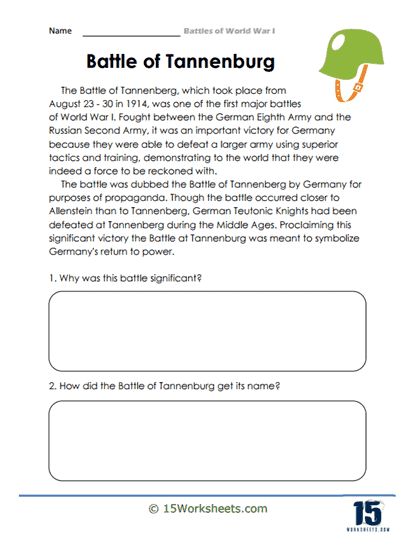Battle of Tannenberg

Worksheet Description
The worksheet centers on the Battle of Tannenberg, a pivotal conflict during World War I that transpired between August 23 and 30 in 1914. It recounts the encounter between the German Eighth Army and the Russian Second Army, highlighting Germany’s tactical superiority that led to its significant victory. In addition to discussing the strategic importance of the battle, the worksheet delves into its symbolic importance, drawing connections between this victory and the historical triumph of the German Teutonic Knights in the Middle Ages. An illustrative helmet icon underscores the militaristic theme of the content.
To adeptly approach the worksheet, students should first read the provided passage thoroughly, ensuring they grasp the main ideas and nuances related to the Battle of Tannenberg. Once they have a comprehensive understanding, they can proceed to answer the questions, ensuring their responses are both detailed and contextualized. Given the historical significance and symbolic implications of the battle, students should aim to incorporate both factual and interpretive elements in their answers. To cement their understanding, it would be advisable for them to cross-reference their responses with additional research or class notes.
Through this worksheet, educators aim to enhance students’ understanding of the Battle of Tannenberg’s significance during World War I and its broader symbolic importance in German history. By juxtaposing the battle’s strategic elements with its historical resonance, the worksheet encourages students to think critically about how past events can be invoked for modern propaganda purposes. This dual-layered approach facilitates a richer grasp of historical events, not just in their immediate context but also in relation to larger narratives and national identities. Essentially, students are nudged to see beyond the mere facts, diving into the depths of historical interpretation and symbolism.
